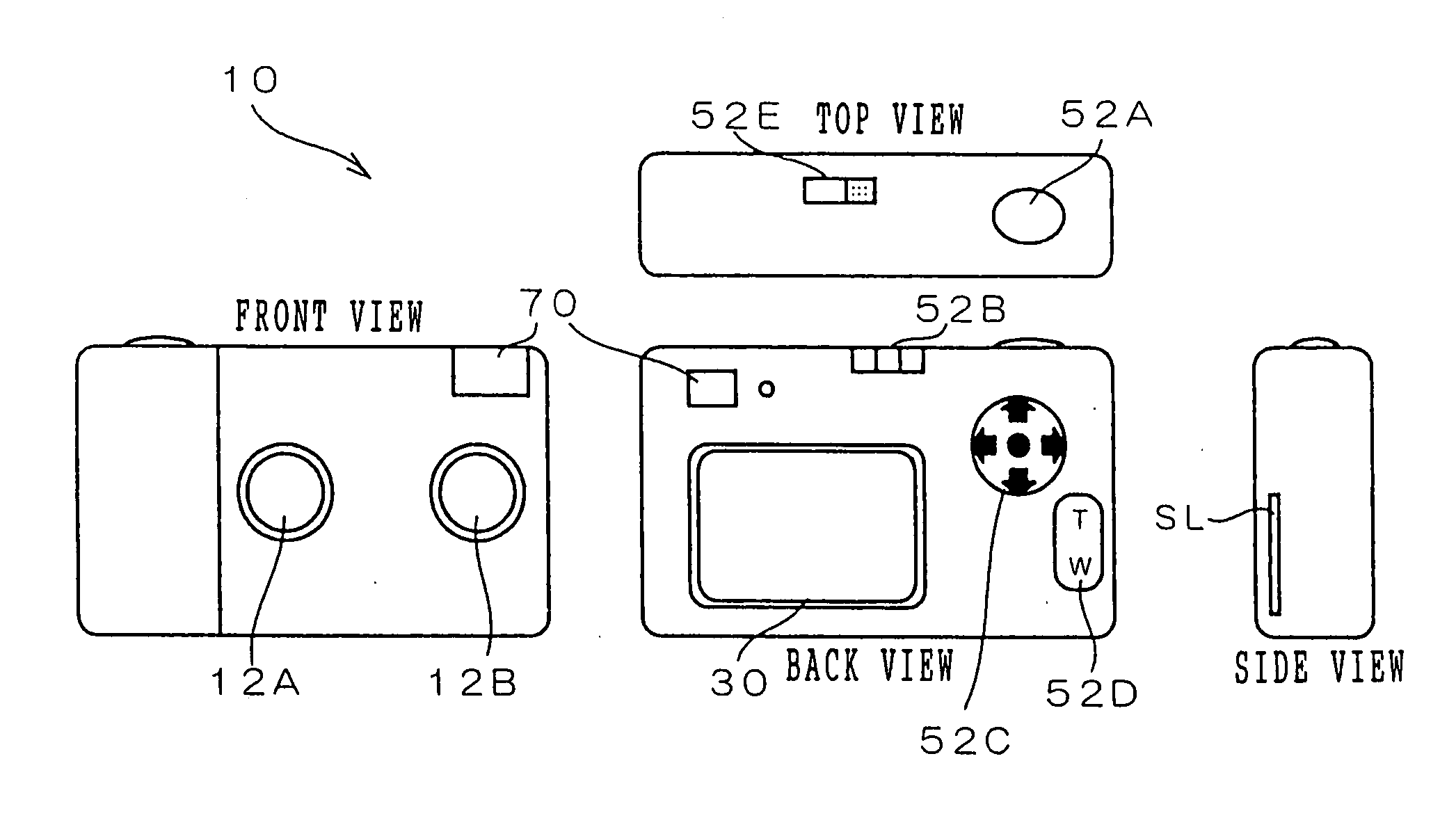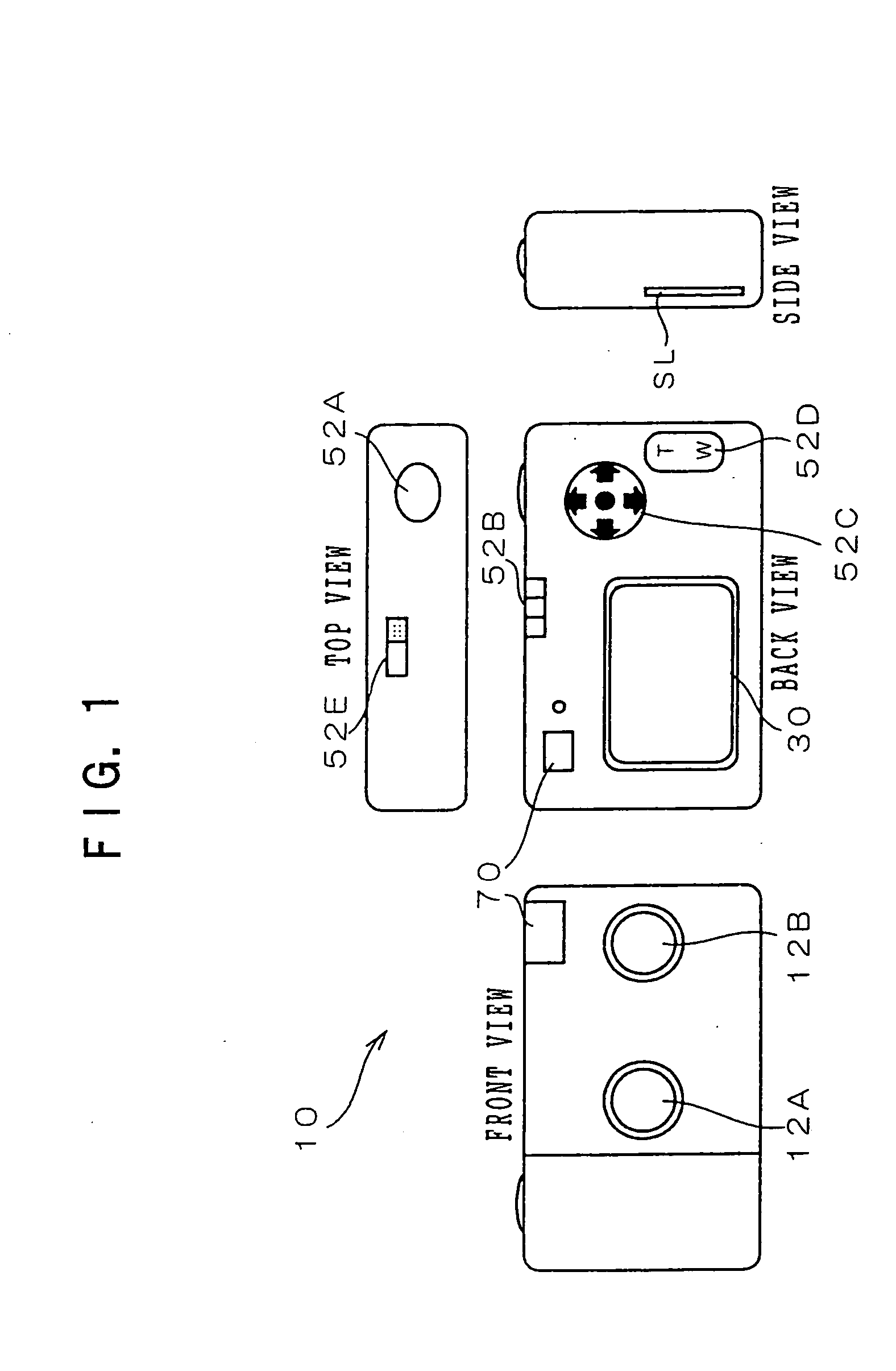Camera and camera zoom control method
a technology of camera and control method, which is applied in the field of camera and camera zoom control method, can solve the problems of reducing the number of photographing images, imposing limits, and large so as to reduce the time difference between the timing of the photographing instruction and the timing of the actual photographing, and reduce the power consumption at the time of zooming.
- Summary
- Abstract
- Description
- Claims
- Application Information
AI Technical Summary
Benefits of technology
Problems solved by technology
Method used
Image
Examples
first embodiment
[0075] First, with reference to FIG. 1, the configuration of the exterior of a digital camera 10 pertaining to the present embodiment will be described. As shown in FIG. 1, the digital camera 10 includes a front surface provided with a pair of lenses 12A and 12B, which are for imaging a subject image, and a viewfinder 70, which is used in order to determine the composition of the subject to be shot.
[0076] The digital camera 10 also includes a top surface provided with a release button (shutter) 52A, which is depressed by the user when executing photographing, and a power switch 52E.
[0077] The release button 52A pertaining to the present embodiment is configured so that depression operations of two stages—one where the release button 52A is depressed to an intermediate position (described by “half-depressed” below) and one where the release button 52A is depressed to a final depressed position below the intermediate position (described by “fully depressed” below)—are detectable. Ad...
second embodiment
[0129] Next, a second embodiment of the invention will be described. Because the configuration of the digital camera pertaining to the second embodiment is the same as that of the digital camera 10 pertaining to the first embodiment, description here will be omitted.
[0130] Processing of the portion relating particularly to the present invention of the processing executed in the digital camera 10 pertaining to the second embodiment at the time of stereo photographing will be described below with reference to FIG. 5 and FIGS. 6A and 6B. FIG. 5 is a flow chart showing the flow of the portion relating particularly to the present invention of the photographing processing executed by the CPU 32 of the digital camera 10 in the case where the stereo photographing mode has been set by the mode switching switch 52B. In FIG. 5, the same step numbers as those of FIG. 3 will be given to steps where processing that is the same as that of FIG. 3 is conducted, and description thereof will be omitt...
third embodiment
[0142] Next, a third embodiment of the invention will be described. Because the configuration of the digital camera pertaining to the third embodiment is the same as that of the digital camera 10 pertaining to the first embodiment, description here will be omitted.
[0143] Processing of the portion relating particularly to the present invention of the processing executed in the digital camera 10 pertaining to the third embodiment at the time of stereo photographing will be described below with reference to FIGS. 7 and 8. FIG. 7 is a flow chart showing the flow of the portion relating particularly to the present invention of the photographing processing executed by the CPU 32 of the digital camera 10 in the case where the stereo photographing mode has been set by the mode switching switch 52B. In FIG. 7, the same step numbers as those of FIG. 5 will be given to steps where processing that is the same as that of FIG. 5 is conducted, and description thereof will be omitted. Also, FIG. 8...
PUM
 Login to View More
Login to View More Abstract
Description
Claims
Application Information
 Login to View More
Login to View More - R&D
- Intellectual Property
- Life Sciences
- Materials
- Tech Scout
- Unparalleled Data Quality
- Higher Quality Content
- 60% Fewer Hallucinations
Browse by: Latest US Patents, China's latest patents, Technical Efficacy Thesaurus, Application Domain, Technology Topic, Popular Technical Reports.
© 2025 PatSnap. All rights reserved.Legal|Privacy policy|Modern Slavery Act Transparency Statement|Sitemap|About US| Contact US: help@patsnap.com



